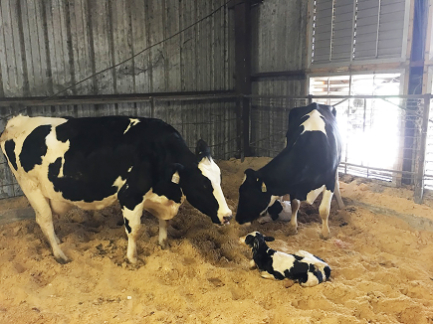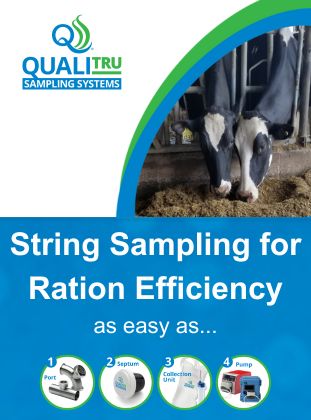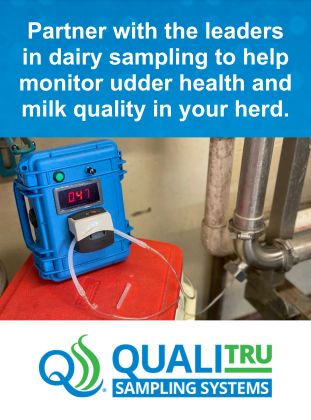Importance of Colostrum for Dairy Calves

By Heather Smith Thomas
Dr. Pete Erickson, Extension Dairy Specialist, University of New Hampshire, says the most important thing for any calf is to get colostrum soon after birth, since it is vital to the calf’s health.
 “We mainly think about colostrum in terms of immunity, but another important ingredient (besides the fluid) is the fat,” he says. This is especially important in cold weather, to give the newborn calf energy and calories to help keep warm.
“We mainly think about colostrum in terms of immunity, but another important ingredient (besides the fluid) is the fat,” he says. This is especially important in cold weather, to give the newborn calf energy and calories to help keep warm.
Colostrum is thicker than regular milk; it has more nutrients and less water. It also serves as a laxative and gut stimulant to help the calf pass its first bowel movements–the dark, sticky meconium. The laxative effect gets the meconium moving through. Colostrum also contains a rich, creamy fat that is easily digested and high in energy–an ideal first meal. A calf that obtains colostrum quickly is much more vigorous (and able to stay warmer in cold weather) than a calf that has not yet suckled. Colostrum has twice the caloric value of normal milk–which is an important factor for the newborn.
“Baby calves have a lower critical temperature of about 55 degrees (below that, they become chilled and stressed). Dairy calves are a little less hardy than beef calves and may need more attention in cold weather. A newborn calf has only about 18 hours of internal fat stores. It is important to get colostrum into that calf soon,” Erickson says.
“We also need to get the calf dried off and warm. Many dairies here have calf warmers—a box with a heat lamp. We dry the calf, dip the navel—everything you’d normally do regardless of the time of year—but the more colostrum you give, the better. Data from Switzerland indicates that the more colostrum we give a calf, the better she will perform later as a cow. We need to provide at least a gallon. Some people give this all at once, some give 2/3 of it at birth and 1/3 a little later, but our data says the gallon needs to be provided before the calf is 12 hours old,” says Erickson.
Traditional wisdom was that colostrum needs to be provided in the first 24 hours, but gut closure begins immediately after birth. It’s a race against time, and it’s also a race between the antibodies in the colostrum and the pathogens the calf encounters. It’s crucial to get the optimum amount of colostrum into the calf as soon as possible.
This is especially important in situations where there’s stress, since stress also hastens gut closure. Calves may not be able to absorb enough antibodies if they are already cold and stressed by the time they get the colostrum. “If the calf is born in a blizzard, or cold weather, or even in a cold barn, it will be stressed.” A difficult birth is also a stress. The calf needs colostrum immediately, to supply the crucial antibodies and needed fat reserves, and this means at least a gallon.
Timing
Timing is crucial, for obtaining adequate disease protection. A calf that gets no colostrum, or not until several hours old, runs a higher risk of developing scours and/or pneumonia in the first weeks of life. Calves with failure of passive transfer (calves that don’t get adequate levels of antibodies or don’t receive colostrum) are most at risk.
For a short while after birth, the calf can absorb antibodies from colostrum directly through the intestinal lining. Veterinarians at Cornell University explain that antibodies are absorbed in a process called pinocytosis, in which cells can draw fluid into themselves. Pinocytosis involves creation of fluid pockets for transporting these large molecules through the wall of the intestine and into the lymph system. Antibodies must be absorbed intact; digestion destroys them. Only about 20% of antibodies reaching the gut are absorbed (most are digested), so the calf must drink a large volume of colostrum soon after birth in order to absorb enough antibodies.
Also crucial is the fact the intestinal lining starts to thicken after birth; the rate of pinocytosis quickly decreases and stops completely by the time the calf is 24 hours old. The optimum time for absorbing antibodies is during the first hour (actually the first 30 minutes) after birth, before the intestinal wall thickens. If the calf is later than 1 or 2 hours with first feeding, only a fraction of the needed antibodies get through.
Traditional wisdom was that colostrum absorption drops by half by the time a calf is 6 hours old, but some studies have shown that by the time a calf is only 4 hours old 75% of the ability to absorb antibodies is lost. After that, absorption rate diminishes rapidly. The veterinarians at Cornell also point out that it’s important the calf get a full feeding of colostrum early on. As soon as the calf gets some colostrum, the gut-closure process is hastened. If a calf is only able to suckle a little, it may be too late for any antibody absorption by the time that calf is fed again.
Colorado State University researchers found that a hard birth can affect a calf’s ability to absorb antibodies. Compared with calves born easily and unassisted, calves delivered with an easy pull had 10% lower concentrations of antibodies, and those born with a hard pull were 21% lower–in spite of the fact the dams were milked immediately and their calves fed the colostrum.
According to the CSU study, calves from a difficult delivery are more likely to suffer stress, oxygen deprivation and acidosis, which can adversely affect their ability to absorb antibodies. Calving difficulty can also affect calf strength and vigor. In this study, the average time it took a calf to get up and stand after birth was 1 hour, 14 minutes for calves delivered with a hard pull, 51 minutes for calves born with an easy pull, and only 40 minutes for those born in easy unassisted births.
It’s also important to make sure the antibody level in the colostrum is adequate. “Ideally, colostrum should be tested with a colostrometer or refractometer. The fat content of colostrum varies. I’ve seen low fat content in Holsteins of 4.5% to around 7% or a little better,” says Erickson. The fat and antibody levels are a bit lower in Holsteins just because of the large volume of fluid.
“The colored breeds have better quality colostrum from an IgG standpoint and fat standpoint (less total volume, and more concentrated solids) but sometimes we run into problems, especially with Jerseys, since they often don’t produce much colostrum in the winter,” says Erickson.
“My first experience with this problem was with a 250-cow Jersey herd in Maine. The dairy wasn’t sure what was happening; some people thought it was genetic, or diet (they’d just put in new corn silage). An interesting study was done at the veterinary school at Washington State University, with a dairy in Texas. They looked at colostrum production in Jerseys throughout the year, and found it varied with the seasons. During winter months, the aged cows (multiparous cows) produced a lot less colostrum. In December, 48% of those cows produced zero colostrum. Those researchers think it has to do with photoperiod and less daylight,” he says.
“Here in New Hampshire we are close to 45 degrees latitude (45th parallel, halfway between the equator and the North Pole), so the days are fairly short during December. We have two dairy herds at UNH and our Jersey herd stops producing colostrum about November. The problem with that herd is that it’s an organic herd, and up until this past year there was no organic colostrum replacer on the market. So we bank frozen colostrum, for use in the winter,” says Erickson.
“Saskatoon Colostrum, which is a great company in Saskatchewan, has an organic colostrum that came on the market about 3 years ago. It’s expensive, but now available for organic dairies,” he says.
Unlike a human baby that picks up immunity while still in the womb, a calf comes into the world completely vulnerable to disease and must receive immunities through its dam’s colostrum. This temporary immunity usually lasts several weeks, until the calf’s own immune system becomes mature enough to start making its own antibodies.
Some cows produce better colostrum than others. During a cow’s life, she comes into contact with many infectious organisms. If she has encountered a disease and developed antibodies against it, she has a “natural” immunity. She can also develop immunities through vaccination. If her vaccinations are up to date, she creates antibodies against those specific diseases, and those antibodies will be in her colostrum to protect her calf as soon as it nurses.
The lack of colostrum in winter is an interesting phenomenon with Jerseys. Some folks think it has to do with diet, and what the cows are fed before calving, but it also seems to be seasonal, affected by shorter days in winter. It may be related to the variation of hormones like melatonin and prolactin. The light (length of daylight) in the cows’ eyes controls melatonin secretion by the pineal gland, with long days resulting in low melatonin concentrations. On days with short photoperiod, melatonin concentrations are high and could inhibit the release of the hormone prolactin and IGF-1. These hormones are essential for induction and maintenance of lactation and their lower concentrations could explain the low colostrum production in cows exposed to reduced photoperiod. More studies are necessary to confirm this theory.
“We had a graduate student doing studies here in New Hampshire. The first study looked at the pre-fresh diet, and the second study looked at photoperiod–putting one group of cows in a barn and give them 16 hours of light daily,” says Erickson. This is similar to putting mares under lights starting in November, to influence the body to think it is spring, so the mares in anestrus will start cycling earlier, for earlier breeding.
“The other group of cows only got 8 hours of light each day, to see if there is an impact on colostrum production. There is data from Maryland and Illinois on lactating cows, showing positive response to more daylight hours. It works commercially, from a lactating cow perspective, so we wanted to see if it has an effect on colostrum production,” says Erickson. Jersey cows reduce production of colostrum in winter. Even though the cows appear to have a full udder, they do not release colostrum until 12 hours later, which may be too late to provide adequate immune development in calves.
Colostrum Substitutes
There are a number of colostrum replacers on the market, but some are more effective than others. There is great variation in quality of products, and price. You usually get what you pay for. There is a difference between colostrum replacers and colostrum supplements–designed to be given with colostrum. Generally they have fairly low IgG concentrations, such as less than 50 grams. These are to be mixed with colostrum. Their effectiveness has not been supported by research.
Colostrum replacers are intended to be fed instead of cow colostrum and as a rule would be higher in terms of antibody concentration, at least 100 grams per dose. There are two kinds of replacers. One is made from plasma. The company gets cattle blood from slaughterhouses and harvests plasma. These types of products have been on and off the market over the years because of BSE. For a while it was thought that all blood-based products should be banned, but in actuality they are considered to have zero risk for transmission of BSE because the organism that causes BSE lives only in the brain and not in blood. In terms of disease risk, it would be very low.
Also, it is treated with radiation, which kills pathogens but does not harm the antibodies. Excessive heating is what destroys antibodies, and this is why you can’t autoclave or pasteurize colostrum at high temperatures. The finished product is tested periodically to make sure no pathogens are coming through, and radiation seems to work.
The other type of replacer is made from bovine colostrum purchased from dairies. It is checked for quality and dried into a powder and irradiated to kill pathogens. The company contracts with dairies to make sure the cows are properly vaccinated, to have antibodies against all major diseases that the calves might be exposed to.
When choosing a replacer, select one that has been tested and performs well. You can’t always go by the amount of antibody it contains. Tests have shown differences in absorption of the IgG by the calf. Calves seem to absorb some products fairly well, and others not so much, and it may be differences in the manufacturing, so it’s best to choose a product that has been tested, with data to show it has worked.
Good replacers can be a time and labor saver. It’s hard to beat fresh colostrum but there are times you just don’t have any, or it might take too long to thaw some banked colostrum. Frozen colostrum will keep up to a year or more in a freezer but if it’s 2 years old the quality may be questionable. The thing that damages it the most, however, is if you thaw it and re-freeze it. Every time you re-freeze it you kill more of the antibodies. If you thaw it out and for some reason don’t have to use it, don’t re-freeze it.
Tips On Feeding Colostrum
There are some diseases that can come through colostrum. Make sure that any fresh or frozen colostrum you use comes from your own herd, or a herd that you trust—that has the same diseases you do or preferably does not have any diseases you don’t have.
With dairy colostrum the calf will need a gallon. Generally you can give this all at once if they’ll drink that much, or use an esophageal feeder and force it into them. Sometimes a calf will nurse half of it from a bottle and then you’d tube feed the rest. Make sure the colostrum is warm enough. It should be above body temperature and feel warm to your finger, but not hot. It will lose some heat during feeding and you don’t want to feed it cool to a cold calf. If nursing from a bottle, the calf will always be more interested if it’s warm.



